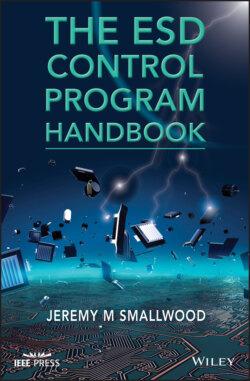Читать книгу The ESD Control Program Handbook - Jeremy M. Smallwood - Страница 61
2.5.1 ESD (Sparks) Between Conducting Objects
ОглавлениеThe spark discharge occurs between conducting electrodes that initially have a high voltage difference between them. Large energies (μJ to >1 J) may be dissipated in very short, or long, times (ns to >ms) depending on discharge circuit (including the load characteristics). Peak currents are typically greater than about 0.1 A and can exceed 100 A. The discharge waveform is highly dependent on the source and “load” circuit characteristics and can have unidirectional or oscillatory waveforms (see Section 2.7).
The energy E stored in a capacitor C charged to voltage V is easily calculated using this simple formula
In the absence of significant series resistance, it is often reasonable to assume that all this energy is transferred to the discharge.
The electrical breakdown field strength of about 3 MV m−1 is valid for normal air pressure and rather large distances (e.g. for a gap of 10 mm and large diameter or flat electrodes, the breakdown voltage would be about 30 kV). The relationship between breakdown field strength and air pressure is given by Paschen's law (Kuffel et al. 2005) and is nearly linear for larger gaps and uniform fields. At smaller gap distances d the breakdown voltage reaches a minimum (known as the Paschen minimum). As breakdown voltage Vb is also dependent on atmospheric pressure P, the Paschen curve is usually plotted as breakdown voltage against the product Pd (Figure 2.11). For air, according to Paschen's law, below about 350 V no breakdown occurs (minimum Pd 0.55 Torr cm, or 7 μm at 1 atm), and ESD can happen only with direct metal‐to‐metal contact. There is evidence that in practice discharges can occur through small gaps below the Paschen minimum voltage, possibly due to field emission (Wallash and Levitt 2003).
